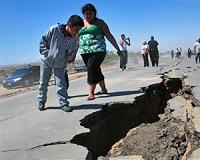| . |  |
. |
Nova Friburgo, Brazil (AFP) Jan 16, 2011 The Brazilian military sent troops and helicopters Sunday to rescue stranded survivors of floods and landslides that killed more than 625 people but the operation was stymied by more bad weather. After rains resumed in the afternoon, the air force had to call back helicopters that had been sent as a lifeline to 80 people stranded since Wednesday in the village of Brejal, in the mountains near Rio de Janeiro, a spokesman said. "The weather conditions do not permit us to advance in the rural areas and to help people who are isolated," said Rio firefighter Colonel Pedro Machado. "We can only make short flights. The teams on the ground are also having a lot of difficulty." The military had hoped to evacuate people in hamlets cut off by rivers of water and mud that carved massive destruction in the Serrana region just north of Rio de Janeiro. Bodies that were buried under rubble and sludge would have to wait until teams with heavy equipment could get to the communities, something that could take days because roads were destroyed. Soldiers, civil defense workers, police and rangers were seen gathering in Nova Friburgo, reinforcing teams that so far have pulled 283 bodies from decimated parts of the town. General Oswaldo de Jesus Ferreira, coordinating the military response, told O Globo newspaper that the 500 troops sent to the Serrana would not only recover bodies but also clear roads and distribute food. The military had 38 vehicles, including two ambulances, and 11 helicopters based out of Teresopolis, another hard-hit town where 268 people died. Although the toll Sunday stood at 626 dead, workers transporting bodies said they feared the overall count will rise as rescuers reached outlying hamlets. "I think in the end we'll see more than 1,000 bodies," said a funeral worker in Teresopolis, Mauricio Berlim. "In one village near here, Campo Grande, there were 2,500 homes and not one is left standing." President Dilma Rousseff has declared three days of mourning, while Rio authorities said their state will observe a full week of mourning starting Monday. At least 14,000 people have been made homeless, officials said, and Rio governor Sergio Cabral declared a state of emergency in seven municipalities. Authorities made an urgent appeal for donations of blood, bottled water, food and medicine, and for medically trained people to help. At least four refrigerated trucks were parked in front of a makeshift morgue inside a Teresopolis church to take bodies as decomposition and disease became concerns. The disaster, which media called the worst tragedy of its kind in Brazil's history, struck sleeping families Wednesday before dawn. Seasonally heavy rains were suddenly intensified by a cold front, dumping a month's worth of precipitation in just eight hours, causing torrents of water and mud that wiped out everything in their path. Water, food and electricity were still lacking in some areas of the Serrana four days after the disaster, with authorities struggling to deliver supplies over fully or partially collapsed roads. Telephone communications were unreliable though progressively being restored. A municipal official in Teresopolis, Solange Sirico, told Brazilian television there was a risk of epidemics breaking out as bodies decomposing in the tropical heat mingled with water runoff. "Also, in all the mountain region, there is a danger of snakes, scorpions and spiders," she added. Forecasters warned that the wet weather was likely to last for a few more days. "We are predicting a light but steady rain, which is not good because it could lay the conditions for more landslides," said the head of the national weather institute, Luiz Cavalcanti. Originally a 19th-century getaway for Brazilian aristocracy, the Serrana region has come to rely on tourism for its livelihood. Nova Friburgo, founded by the Swiss in 1819, has ongoing close ties with Geneva, where the foreign ministry said a team of expert relief workers would arrive later Sunday to assess the community's urgent needs.
Share This Article With Planet Earth
Related Links Bringing Order To A World Of Disasters A world of storm and tempest When the Earth Quakes
 Study Explores How People Respond To Climate Disasters
Study Explores How People Respond To Climate DisastersWaco TX (SPX) Jan 17, 2011 New results from a Baylor University study show that different behaviors and strategies lead some families to cope better and emerge stronger after a weather-related event. Dr. Sara Alexander, an applied social anthropologist at Baylor who conducts much of her research in Central America, studied different households in several coastal communities in Belize. While climate change has been a ... read more |
|
| The content herein, unless otherwise known to be public domain, are Copyright 1995-2010 - SpaceDaily. AFP and UPI Wire Stories are copyright Agence France-Presse and United Press International. ESA Portal Reports are copyright European Space Agency. All NASA sourced material is public domain. Additional copyrights may apply in whole or part to other bona fide parties. Advertising does not imply endorsement,agreement or approval of any opinions, statements or information provided by SpaceDaily on any Web page published or hosted by SpaceDaily. Privacy Statement |